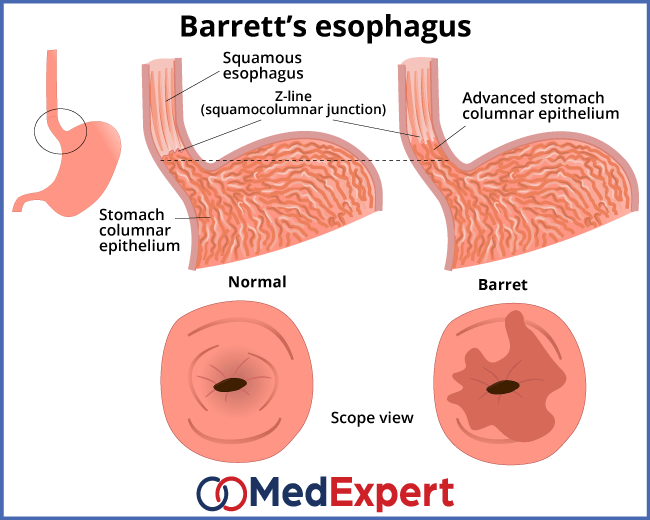BARRETT’S OESOPHAGUS
An abnormal condition of the oesophagus, which occurs due to continuous impact of stomach acid onto oesophageal mucous lining is called Barrett`s syndrome or Barrett`s oesophagus. Barrett`s syndrome symptoms are very specific and include regular heartburn, belching, chest pain, etc. Barrett`s oesophagus treatment depends on the stage of the disease and severity of symptoms. Below we will review in more detail the nature of this disorder, its causes, as well as Barrett`s esophagus treatment options and diagnostics services.
Barrett’s oesophagus is a condition where the cells of the oesophagus (gullet) grow abnormally.
This condition is normally diagnosed in patients who have long-term gastroesophageal reflux disease (GERD) that is a chronic regurgitation of acid from the stomach into the lower oesophagus.
About ten percent of people with chronic GERD will develop Barrett’s oesophagus.

This condition is associated with an increased risk of developing oesophageal cancer. Even though the risk is small, regular checkups for pre-cancerous cells are important. Early detection of the condition can prevent oesophageal cancer.
How does GERD relate to Barrett’s oesophagus?
Symptoms of GERD may include heartburn, a sour, burning sensation in the back of the throat, chronic cough, laryngitis, and nausea.
when you eat, food automatically passes through your oesophagus to your stomach. the lower oesophageal sphincter, a ring of muscle at the end of the oesophagus keeps stomach contents from rising up into the oesophagus.
your stomach produces acid to digest food but it is protected from the acid it produces. in patients with GERD, stomach content flows backward into th oesophagus (reflux).
Most of the times, people with acid reflux don’t develop Barrett’s esophagus. However, the cells in patients with frequent acid reflux may eventually be replaced with cells that are similar to intestinal cells to become Barrett’s esophagus.
Does GERD always lead to Barrett’s esophagus?
No. Not everyone with GERD will develop Barrett’s oesophagus and not everyone with the condition has GERD. However, long term GERD is the primary risk factor of developing the condition.
While anyone can develop the condition, white males with long-term GERD are more likely than others to develop it. Other risk factors include the onset of GERD at a young age and/or a history of smoking.
Barrett’s oesophagus symptoms
Most people with Barrett’s oesophagus experience no signs and symptoms, but may experience the following signs and symptoms below due to GERD:
- Frequent heartburn
- Difficulty swallowing food
- Chest pain (less common)
BARRETT’S OESOPHAGUS TREATMENT OPTIONS
Several treatments that are designed specially to focus on abnormal tissue include:
-
- Radiofrequency ablation (RFA): Radio waves are delivered through an endoscope inserted into the oesophagus. This aims to destroy abnormal cells while protecting the healthy cells.
- Photodynamic therapy (PDT): A laser is used through an endoscope to destroy abnormal cells in the lining without causing damage to normal tissue. You may be required to take a drug known as Photofrin, which causes cells to become light sensitive before the procedure.
- Endoscopic spray cryotherapy: This is a newer technique that uses cold nitrogen or carbon dioxide gas through the endoscope to freeze the abnormal cells.
- Endoscopic mucosal resection (EMR): The abnormal lining is lifted and cut off the wall of the oesophagus before it’s removed through the endoscope. The goal of this procedure is to remove any pre-cancerous or cancer cells contained in the lining. An ultrasound will be performed first if cancer cells are present to make sure it hasn’t moved deeper into the oesophagus walls.
- Surgery: When severe pre-cancer (dysplasia) or cancer has been diagnosed, surgery could be used to remove most of the oesophagus. The sooner the surgery is completed following the diagnosis, the better the chance for the cure.
DIAGNOSING BARRETT’S OESOPHAGUS
- Gastroscopy: Endoscopy is typically used to determine if you have Barrett’s oesophagus.
An endoscope is passed down your throat to check for signs of changing oesophagus tissue. Normal oesophagus tissue appears pale and glossy whereas the tissue in Barrett’s oesophagus is red and velvety.
Your surgeon will most likely remove a small tissue sample to be examined (biopsy). The biopsy can be examined to determine the degree of tissue change.
DETERMINING THE DEGREE OF TISSUE CHANGE DUE TO BARRETT’S OESOPHAGUS
A pathologist who specializes in examining tissues will determines the degree of dysplasia in your oesophagus cells. Your tissue may be classified as:
- No dysplasia: Barrett’s oesophagus is present but no pre-cancerous changes are found in the cells
- Low-grade dysplasia: Cells show small signs of pre-cancerous changes
- High-grade dysplasia: Cells show many changes. This grade is thought to be the final level before the cells turn into oesophageal cancer


